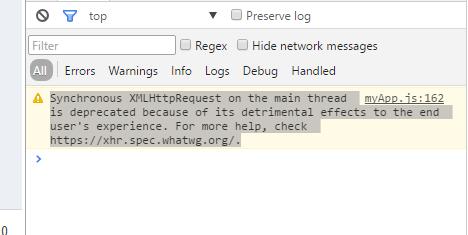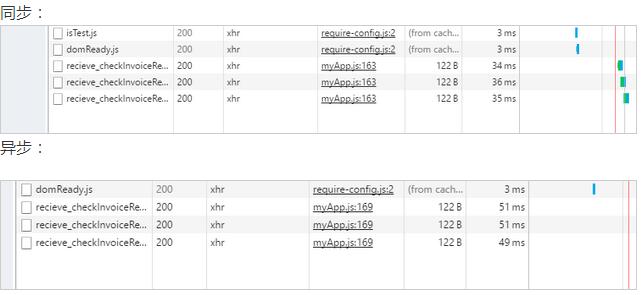 Web Front-end
Web Front-end
 JS Tutorial
JS Tutorial
 Detailed explanation of the problem of sending AJAX requests in JavaScript for loop_jquery
Detailed explanation of the problem of sending AJAX requests in JavaScript for loop_jquery
Detailed explanation of the problem of sending AJAX requests in JavaScript for loop_jquery
First of all, it is rare that this problem occurs because there are too many better solutions. When doing ajax today, an interesting thing is that a get request must be sent in each iteration. Because the iteration speed is too fast, the next iteration will be carried out before a request is completed. On chrome and ff, except for the last one Except for the request, all other requests have been cancelled. So what to do? Set a delay (not so good) or some other way?
There are many ways, such as setting sleep, iteration, etc. I use two other solutions.
1. Synchronous ajax request , and ajax request is asynchronous by default, so it should be set to false.
function creatXMLHttpRequest() {
var xmlHttp;
if (window.ActiveXObject) {
return xmlHttp = new ActiveXObject("Microsoft.XMLHTTP");
} else if (window.XMLHttpRequest) {
return xmlHttp = new XMLHttpRequest();
}
}
function disButton(name, actionName, resquestParmName) {
var path = document.getElementById("path").value;
var xmlHttp = creatXMLHttpRequest();
var invoiceIds = new Array();
invoiceIds = document.getElementsByName(name);
// 迭代的速度快于发送请求+收到回复的时间 所以一次get请求都还没有完成就进行了下一次请求
for (i = 0; i < invoiceIds.length; i++) {
var invoiceId = invoiceIds[i].value;
var url = path + "/" + actionName + ".action?" + resquestParmName + "="
+ invoiceId;
xmlHttp.onreadystatechange = function() {
if (xmlHttp.readyState == 4) {
if (xmlHttp.status == 200) {
var result = xmlHttp.responseText;
if (result == "0") {
document.getElementById("btn" + invoiceId).disabled = "disabled";
}
}
}
}
xmlHttp.open("GET", url, false);
xmlHttp.send(null);
}
}
In this way, using synchronous ajax request, you will wait for the server to respond, execute the code, and then continue to iterate. But it seems that this is not recommended.

2. Use an asynchronous method , but remember that a new XMLHttpRequest object must be created for each iteration and cannot be reused.
function creatXMLHttpRequest() {
var xmlHttp;
if (window.ActiveXObject) {
return xmlHttp = new ActiveXObject("Microsoft.XMLHTTP");
} else if (window.XMLHttpRequest) {
return xmlHttp = new XMLHttpRequest();
}
}
function disButton(name, actionName, resquestParmName) {
var xmlHttp;
var path = document.getElementById("path").value;
var invoiceIds = new Array();
invoiceIds = document.getElementsByName(name);
// 迭代的速度快于发送请求+收到回复的时间 所以一次get请求都还没有完成就进行了下一次请求
for (i = 0; i < invoiceIds.length; i++) {
xmlHttp = creatXMLHttpRequest();
var invoiceId = invoiceIds[i].value;
var url = path + "/" + actionName + ".action?" + resquestParmName + "="
+ invoiceId;
fu(xmlHttp,url,invoiceId);
}
}
function fu(xmlHttp,url,invoiceId){
xmlHttp.onreadystatechange = function() {
if (xmlHttp.readyState == 4) {
if (xmlHttp.status == 200) {
var result = xmlHttp.responseText;
if (result == "0") {
document.getElementById("btn" + invoiceId).disabled = "disabled";
}
}
}
}
//
xmlHttp.open("GET", url, true);
xmlHttp.send(null);
}Since the JS for loop and ajax run asynchronously, the for loop ends but ajax has not yet been executed. If an asynchronous request method is used, if a new XMLHttpRequest is made during each iteration, each request can be completed, but the result is still inaccurate, and some programs have not been executed.
Understand, it turns out that each iteration is to execute a few lines of code. The code for sending asynchronous ajax requests should be placed in a function, and this function should be called every iteration. That's it.
In terms of performance, For this iterative ajax request, it seems that the synchronous method has higher performance.

This problem has been solved and my understanding of ajax and http has been deepened.
The above introduces the problem of sending AJAX requests in the JavaScript for loop. I hope it will be helpful to friends who are interested in Javascript tutorials.

Hot AI Tools

Undresser.AI Undress
AI-powered app for creating realistic nude photos

AI Clothes Remover
Online AI tool for removing clothes from photos.

Undress AI Tool
Undress images for free

Clothoff.io
AI clothes remover

Video Face Swap
Swap faces in any video effortlessly with our completely free AI face swap tool!

Hot Article

Hot Tools

Notepad++7.3.1
Easy-to-use and free code editor

SublimeText3 Chinese version
Chinese version, very easy to use

Zend Studio 13.0.1
Powerful PHP integrated development environment

Dreamweaver CS6
Visual web development tools

SublimeText3 Mac version
God-level code editing software (SublimeText3)

Hot Topics
 How to implement an online speech recognition system using WebSocket and JavaScript
Dec 17, 2023 pm 02:54 PM
How to implement an online speech recognition system using WebSocket and JavaScript
Dec 17, 2023 pm 02:54 PM
How to use WebSocket and JavaScript to implement an online speech recognition system Introduction: With the continuous development of technology, speech recognition technology has become an important part of the field of artificial intelligence. The online speech recognition system based on WebSocket and JavaScript has the characteristics of low latency, real-time and cross-platform, and has become a widely used solution. This article will introduce how to use WebSocket and JavaScript to implement an online speech recognition system.
 WebSocket and JavaScript: key technologies for implementing real-time monitoring systems
Dec 17, 2023 pm 05:30 PM
WebSocket and JavaScript: key technologies for implementing real-time monitoring systems
Dec 17, 2023 pm 05:30 PM
WebSocket and JavaScript: Key technologies for realizing real-time monitoring systems Introduction: With the rapid development of Internet technology, real-time monitoring systems have been widely used in various fields. One of the key technologies to achieve real-time monitoring is the combination of WebSocket and JavaScript. This article will introduce the application of WebSocket and JavaScript in real-time monitoring systems, give code examples, and explain their implementation principles in detail. 1. WebSocket technology
 How to use JavaScript and WebSocket to implement a real-time online ordering system
Dec 17, 2023 pm 12:09 PM
How to use JavaScript and WebSocket to implement a real-time online ordering system
Dec 17, 2023 pm 12:09 PM
Introduction to how to use JavaScript and WebSocket to implement a real-time online ordering system: With the popularity of the Internet and the advancement of technology, more and more restaurants have begun to provide online ordering services. In order to implement a real-time online ordering system, we can use JavaScript and WebSocket technology. WebSocket is a full-duplex communication protocol based on the TCP protocol, which can realize real-time two-way communication between the client and the server. In the real-time online ordering system, when the user selects dishes and places an order
 How to implement an online reservation system using WebSocket and JavaScript
Dec 17, 2023 am 09:39 AM
How to implement an online reservation system using WebSocket and JavaScript
Dec 17, 2023 am 09:39 AM
How to use WebSocket and JavaScript to implement an online reservation system. In today's digital era, more and more businesses and services need to provide online reservation functions. It is crucial to implement an efficient and real-time online reservation system. This article will introduce how to use WebSocket and JavaScript to implement an online reservation system, and provide specific code examples. 1. What is WebSocket? WebSocket is a full-duplex method on a single TCP connection.
 JavaScript and WebSocket: Building an efficient real-time weather forecasting system
Dec 17, 2023 pm 05:13 PM
JavaScript and WebSocket: Building an efficient real-time weather forecasting system
Dec 17, 2023 pm 05:13 PM
JavaScript and WebSocket: Building an efficient real-time weather forecast system Introduction: Today, the accuracy of weather forecasts is of great significance to daily life and decision-making. As technology develops, we can provide more accurate and reliable weather forecasts by obtaining weather data in real time. In this article, we will learn how to use JavaScript and WebSocket technology to build an efficient real-time weather forecast system. This article will demonstrate the implementation process through specific code examples. We
 Simple JavaScript Tutorial: How to Get HTTP Status Code
Jan 05, 2024 pm 06:08 PM
Simple JavaScript Tutorial: How to Get HTTP Status Code
Jan 05, 2024 pm 06:08 PM
JavaScript tutorial: How to get HTTP status code, specific code examples are required. Preface: In web development, data interaction with the server is often involved. When communicating with the server, we often need to obtain the returned HTTP status code to determine whether the operation is successful, and perform corresponding processing based on different status codes. This article will teach you how to use JavaScript to obtain HTTP status codes and provide some practical code examples. Using XMLHttpRequest
 How to use insertBefore in javascript
Nov 24, 2023 am 11:56 AM
How to use insertBefore in javascript
Nov 24, 2023 am 11:56 AM
Usage: In JavaScript, the insertBefore() method is used to insert a new node in the DOM tree. This method requires two parameters: the new node to be inserted and the reference node (that is, the node where the new node will be inserted).
 How to extend the timeout of Ajax requests?
Jan 26, 2024 am 10:09 AM
How to extend the timeout of Ajax requests?
Jan 26, 2024 am 10:09 AM
How to extend the expiration time of Ajax requests? When making network requests, we often encounter situations where we need to process large amounts of data or complex calculations, which may cause the request to time out and fail to return data normally. In order to solve this problem, we can ensure that the request can be completed successfully by extending the expiration time of the Ajax request. The following will introduce some methods and specific code examples to extend the expiration time of Ajax requests. When making an Ajax request using the timeout attribute, you can set the timeout attribute to





